JAVA introductory system tutorial (5) Basic syntax (3)
1. Loop statement: for / while / do...while
1) for loop
Format: for (loop variable initialization; loop variable condition; loop invariant change) {
using use using ’s ’ using ’s ’ using ’ s ‐ ‐ ‐ ‐ ‐ ‐ ‐ } }
1>Execute the loop variable initialization part and set the loop initialization status. This part is only executed once in the loop
Judge the loop condition. If it is true, the code in the loop will be executed. If it is false, exit the loop directly
(Note: There is no need to add semicolons where there are braces, and there is no need to add braces where there are semicolons)
Example question : Sum, find the sum of 1~100
##2) while loop
Format: while (judgment condition){
’ s ’ s ‐ ‐ ‐ ‐ ‐ ‐ to # Execution process:
Determine whether the condition behind while is true
Example: Enter 1-5
in succession 3) do...while loop
Format: do{} While (Judgment Conditions) ::
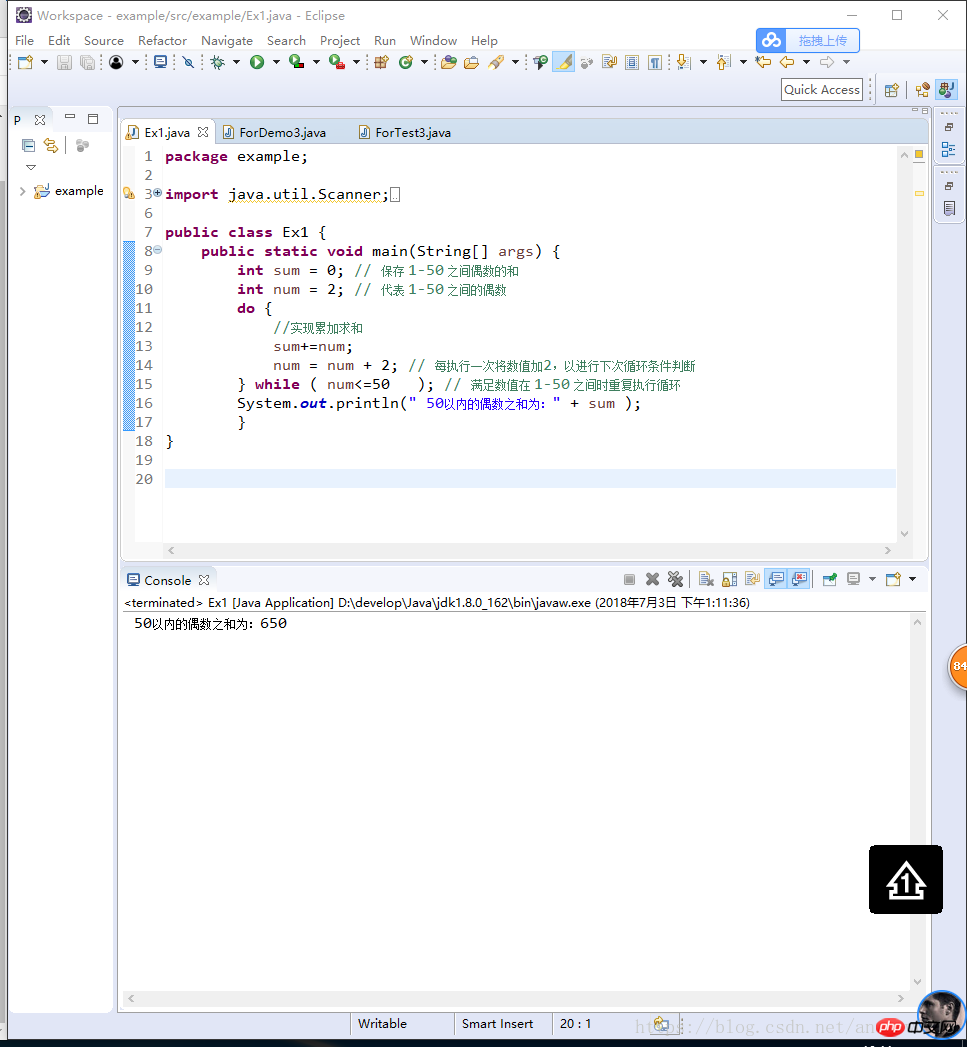 & LT; 1 & GT;
& LT; 1 & GT;
Example: Calculate the sum of even numbers within 50
## 4) Loop Nesting
Example: Type a 9X9 multiplication table ps: continue: Stop the current loop and enter the next step A loop, break: end the loop2. Array: An array can be understood as a huge box, which can store multiple data of the same type in order. 
 The subscripts of the array start from 0, that is, score[0 here ] = 76 . . . . . . score[3] = 87
The subscripts of the array start from 0, that is, score[0 here ] = 76 . . . . . . score[3] = 87
Initialization of the array: 1) Dynamic initialization: Specify the length of the array, and the system will assign values to the elements in the array
(The format here is: data type [ ] array name = new array type [specified length] )2) Static initialization: Specify the value of the element in the array, and the system will specify the length of the array
Treatment of data in the array: We can operate and process the array of the assigned value
# We can directly create an array method. Merging completed
to be completed, such as: int[ ] sc = new int[ ]{5,15,25,35,48,55,38}
Array: length attribute: Get the length of the array
Example: Enter a set of data and output the array
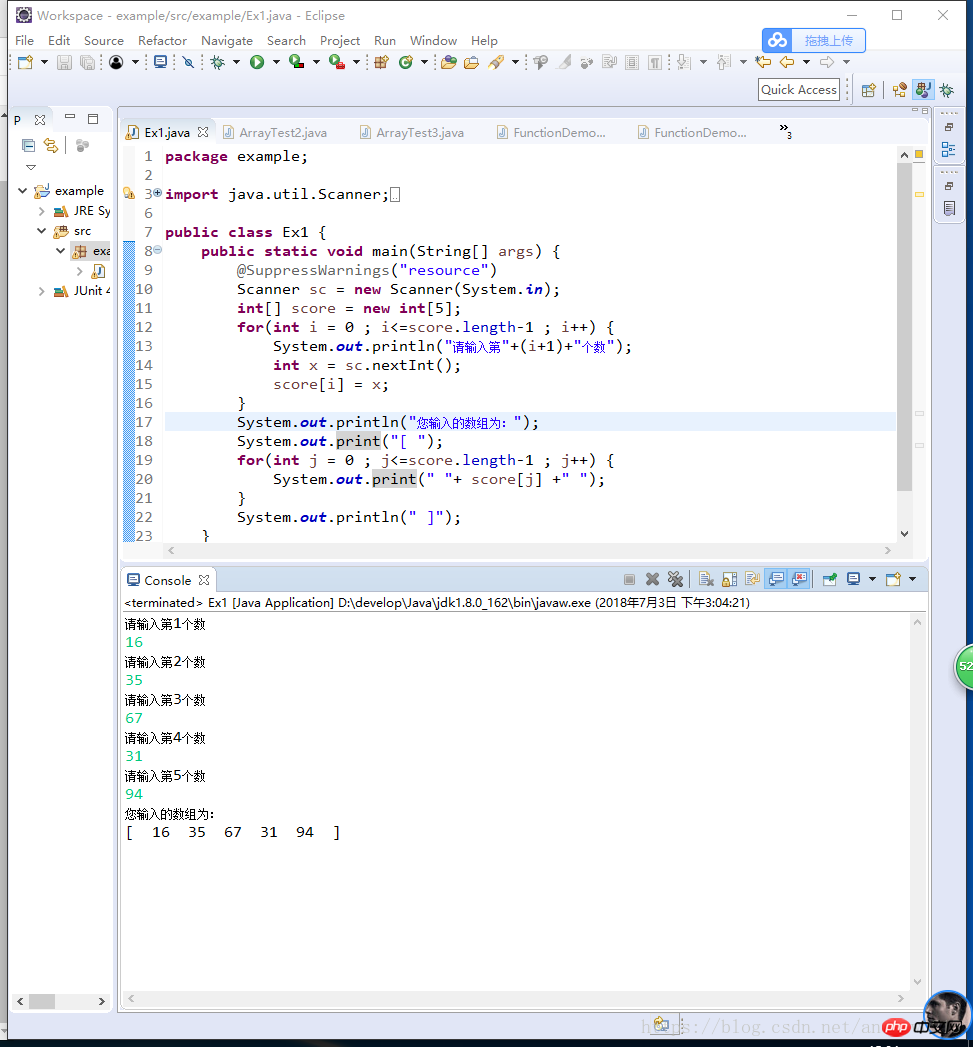
3. Method: Method It is an ordered combination of codes used to solve a type of problem, that is, a functional module
Syntax: access modifier return value type method name (parameter list) {
Method Sports
# 1) Access decoration: Method allows the scope of permissions to be accessed. , the use of other modifiers will be explained in detail in later chapters
2) Return value type: the type of the method return value, if the method does not return any value, the return value type is specified as void; if If the method has a return value, you need to specify the type of the return value, and use the return statement in the method body to return the value
3) Method name: The name of the defined method must use a legal identifier
4) Parameter list: Parameter list passed to the method. There can be multiple parameters. Multiple parameters are separated by commas. Each parameter consists of parameter type and parameter name, separated by spaces
Methods can be divided into four categories according to whether they have parameters and return values:
Ø Methods without parameters and return values
Ø Methods without parameters and return values
Ø Method with parameters and no return value
Ø Method with parameters and return value
Calling method:
1) Single call: no specific result
2) Output call: not enough Okay, the data is hard-coded and output directly. There is no further requirement for the results
3) Assignment call
Example: In the previous example, we added a method to optimize the sorting process.
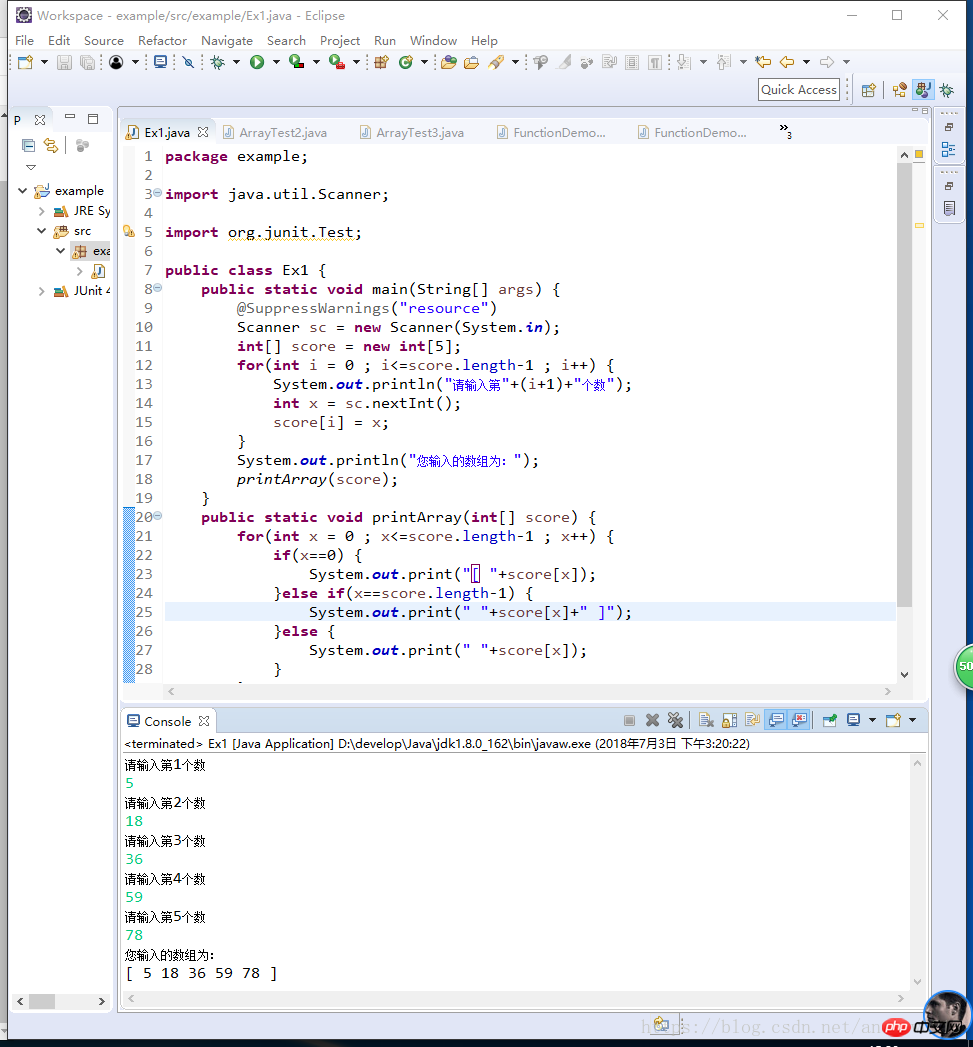
Question: Based on what we have learned before, we will make a set of more complex program requirements as follows
1) Input a set of arrays 2) Output the array 3) Inverse output of the array 4) You can filter out the maximum and minimum numbers and output them 5) Add data query function 6) Use methods to optimize the program process
package example;
import java.util.Scanner;
public class Ex1 { public static void main(String[] args) { @SuppressWarnings("resource") Scanner sc = new Scanner(System.in); int[] score = new int[5]; for(int i = 0 ; i<=score.length-1 ; i++) { System.out.println("请输入第"+(i+1)+"个数"); int x = sc.nextInt();
score[i] = x; } System.out.print("您输入的数组为:");
printArray(score);
max(score, 0);
min(score, 0);
nx(score,0);
printArray(score);
where(score); } //遍历数组方法 public static void printArray(int[] score) { for(int x = 0 ; x<=score.length-1 ; x++) { if(x==0) { System.out.print("[ "+score[x]); }else if(x==score.length-1) { System.out.print(" "+score[x]+" ]"); }else { System.out.print(" "+score[x]); } } System.out.println(""); System.out.println("------------------------"); } //输出最大值方法 public static void max(int[] score, int max) { max = score[0]; for(int y = 1 ; y<=score.length-1 ; y++) { if (max<score[y]) { max = score[y]; } } System.out.println("您输入的最大值为:"+max); System.out.println("------------------------"); } //输出最小值方法 public static void min(int[] score, int min) { min = score[0]; for(int y = 1 ; y<=score.length-1 ; y++) { if (min>score[y]) { min = score[y]; } } System.out.println("您输入的最小值为:"+min); System.out.println("------------------------"); } //逆序方法 public static void nx(int[] score,int temp) { for(int y = 0 ; y<=(score.length-1)/2 ; y++) { temp = score[y]; score[y]=score[score.length-1-y]; score[score.length-1-y]=temp; } System.out.print("该数组的逆序为:"); } //查找数据方法 public static void where(int[] score) { @SuppressWarnings("resource") Scanner sc = new Scanner(System.in); System.out.print("请输入您要查找的数: "); int ex = sc.nextInt(); for(int y = 0 ; y<score.length ; y++) { if(ex == score[y]) { System.out.println("您输入的是第 "+(y+1)+" 个数"); break; }else if(ex!=score[0] && ex!=score[1] && ex!=score[2] && ex!=score[3] && ex!=score[4]) { System.out.println("没有您要找的数"); break; } } } }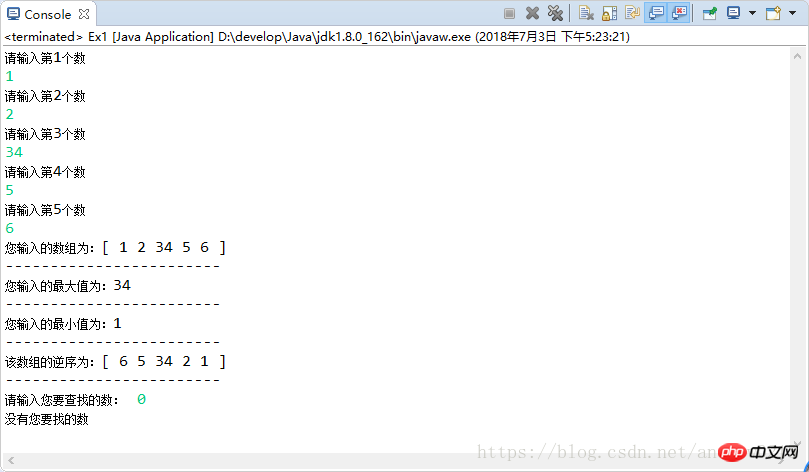
Supplement: Method overloading
If the same class contains two or more methods with the same method name and different number, order or type of method parameters, It is called the overloading of the method, and it can also be said that the method is overloaded. As shown below, the four method names are all show, but the parameters of the methods are different, so they are all overloaded methods:
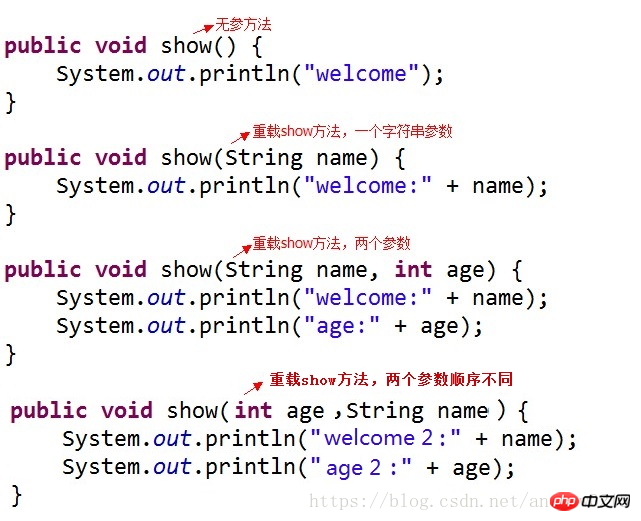
##How to distinguish which overloaded method is called?


PS: Basis for judging method overloading
1. Must be in the same class
2. Method The names are the same
3. The number, order or type of method parameters are different
4. It has nothing to do with the modifiers or return values of the methods
#END
JAVA Getting Started System Tutorial (3) Basic Grammar (1) JAVA introductory system tutorial (4) Basic syntax (2) ######The above is the detailed content of JAVA introductory system tutorial (5) Basic syntax (3). For more information, please follow other related articles on the PHP Chinese website!

Hot AI Tools

Undresser.AI Undress
AI-powered app for creating realistic nude photos

AI Clothes Remover
Online AI tool for removing clothes from photos.

Undress AI Tool
Undress images for free

Clothoff.io
AI clothes remover

Video Face Swap
Swap faces in any video effortlessly with our completely free AI face swap tool!

Hot Article

Hot Tools

Notepad++7.3.1
Easy-to-use and free code editor

SublimeText3 Chinese version
Chinese version, very easy to use

Zend Studio 13.0.1
Powerful PHP integrated development environment

Dreamweaver CS6
Visual web development tools

SublimeText3 Mac version
God-level code editing software (SublimeText3)

Hot Topics
 1655
1655
 14
14
 1413
1413
 52
52
 1306
1306
 25
25
 1252
1252
 29
29
 1226
1226
 24
24
 Break or return from Java 8 stream forEach?
Feb 07, 2025 pm 12:09 PM
Break or return from Java 8 stream forEach?
Feb 07, 2025 pm 12:09 PM
Java 8 introduces the Stream API, providing a powerful and expressive way to process data collections. However, a common question when using Stream is: How to break or return from a forEach operation? Traditional loops allow for early interruption or return, but Stream's forEach method does not directly support this method. This article will explain the reasons and explore alternative methods for implementing premature termination in Stream processing systems. Further reading: Java Stream API improvements Understand Stream forEach The forEach method is a terminal operation that performs one operation on each element in the Stream. Its design intention is
 PHP: A Key Language for Web Development
Apr 13, 2025 am 12:08 AM
PHP: A Key Language for Web Development
Apr 13, 2025 am 12:08 AM
PHP is a scripting language widely used on the server side, especially suitable for web development. 1.PHP can embed HTML, process HTTP requests and responses, and supports a variety of databases. 2.PHP is used to generate dynamic web content, process form data, access databases, etc., with strong community support and open source resources. 3. PHP is an interpreted language, and the execution process includes lexical analysis, grammatical analysis, compilation and execution. 4.PHP can be combined with MySQL for advanced applications such as user registration systems. 5. When debugging PHP, you can use functions such as error_reporting() and var_dump(). 6. Optimize PHP code to use caching mechanisms, optimize database queries and use built-in functions. 7
 PHP vs. Python: Understanding the Differences
Apr 11, 2025 am 12:15 AM
PHP vs. Python: Understanding the Differences
Apr 11, 2025 am 12:15 AM
PHP and Python each have their own advantages, and the choice should be based on project requirements. 1.PHP is suitable for web development, with simple syntax and high execution efficiency. 2. Python is suitable for data science and machine learning, with concise syntax and rich libraries.
 PHP vs. Other Languages: A Comparison
Apr 13, 2025 am 12:19 AM
PHP vs. Other Languages: A Comparison
Apr 13, 2025 am 12:19 AM
PHP is suitable for web development, especially in rapid development and processing dynamic content, but is not good at data science and enterprise-level applications. Compared with Python, PHP has more advantages in web development, but is not as good as Python in the field of data science; compared with Java, PHP performs worse in enterprise-level applications, but is more flexible in web development; compared with JavaScript, PHP is more concise in back-end development, but is not as good as JavaScript in front-end development.
 PHP vs. Python: Core Features and Functionality
Apr 13, 2025 am 12:16 AM
PHP vs. Python: Core Features and Functionality
Apr 13, 2025 am 12:16 AM
PHP and Python each have their own advantages and are suitable for different scenarios. 1.PHP is suitable for web development and provides built-in web servers and rich function libraries. 2. Python is suitable for data science and machine learning, with concise syntax and a powerful standard library. When choosing, it should be decided based on project requirements.
 Java Program to Find the Volume of Capsule
Feb 07, 2025 am 11:37 AM
Java Program to Find the Volume of Capsule
Feb 07, 2025 am 11:37 AM
Capsules are three-dimensional geometric figures, composed of a cylinder and a hemisphere at both ends. The volume of the capsule can be calculated by adding the volume of the cylinder and the volume of the hemisphere at both ends. This tutorial will discuss how to calculate the volume of a given capsule in Java using different methods. Capsule volume formula The formula for capsule volume is as follows: Capsule volume = Cylindrical volume Volume Two hemisphere volume in, r: The radius of the hemisphere. h: The height of the cylinder (excluding the hemisphere). Example 1 enter Radius = 5 units Height = 10 units Output Volume = 1570.8 cubic units explain Calculate volume using formula: Volume = π × r2 × h (4
 PHP's Impact: Web Development and Beyond
Apr 18, 2025 am 12:10 AM
PHP's Impact: Web Development and Beyond
Apr 18, 2025 am 12:10 AM
PHPhassignificantlyimpactedwebdevelopmentandextendsbeyondit.1)ItpowersmajorplatformslikeWordPressandexcelsindatabaseinteractions.2)PHP'sadaptabilityallowsittoscaleforlargeapplicationsusingframeworkslikeLaravel.3)Beyondweb,PHPisusedincommand-linescrip
 PHP: The Foundation of Many Websites
Apr 13, 2025 am 12:07 AM
PHP: The Foundation of Many Websites
Apr 13, 2025 am 12:07 AM
The reasons why PHP is the preferred technology stack for many websites include its ease of use, strong community support, and widespread use. 1) Easy to learn and use, suitable for beginners. 2) Have a huge developer community and rich resources. 3) Widely used in WordPress, Drupal and other platforms. 4) Integrate tightly with web servers to simplify development deployment.




